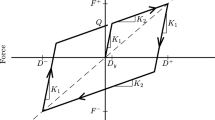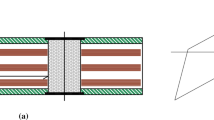Abstract
This work investigates the efficiency of mixed base isolation, combining passive isolation bearings with semi-active (SAC) devices, to reduce the floor spectral acceleration in the vicinity of the non-isolated modes’ frequencies. Both analytical and experimental studies have been carried out. Analytical results of the behaviour of a multiple degree of freedom base isolated structure demonstrate the efficacy of the method. Though the considered controller is based on a reduced order model with only two degrees of freedom (2 DOF) without spillover compensation, the results show that, for the type of structures studied here, spillover effects are not considerable. An experimental study of a 2 DOF model of a base isolated structure equipped with a semi-active magneto-rheological (MR) damper has been carried out. Due to limitations of the experimental set-up, it has not been possible to obtain direct experimental evidence of the efficacy of SAC control to improve floor spectra. Nevertheless, based on the good agreement between analytical and experimental results which validate the considered MR model and control algorithm, numerical analyses of more relevant configurations illustrated the benefit of the utilization of such devices.
Similar content being viewed by others
References
Alhan C, Gavin H (2004) A parametric study of linear and non-linear passively damped seismic isolation systems for buildings. Eng Struct 26(4): 485–497
Bahar A, Pozo F, Acho L, Rodellar J, Barbat A (2010) Parameter identification of large-scale magnetorheological dampers in a benchmark building. Comput Struct 88: 198–206
Building Seismic Safety Council (2001) NEHRP Recommended provisions for seismic regulations for new buildings and other structures. FEMA 368, 369. National Institute of Building Sciences
Chang C-M, Park K-S, Mullenix A, Spencer BF (2008) Semiactive control strategy for a phase II smart base isolated benchmark building. Struct Control Health Monitor 15: 673–696
Choi SB, Lee SK, Park YP (2001) A hysteresis model for the field-dependent damping force of a magnetorheological damper. J Sound Vib 245(2): 375–383
Dyke SJ, Spencer BF, Sain MK, Carlson JD (1998) An experimental study of MR dampers for seismic protection. Smart Mater Struct 7(5): 693–703
Gavin H, Alhan C, Oka N (2003) Fault tolerance of semi-active seismic isolation. J Struct Eng 129(7): 922–932
Glad T, Ljung L (2000) Control theory: multivariable and nonlinear methods. Taylor & Francis, London
Hancock J, Watson-Lampreyb J, Abrahamsonc NA, Bommer JJ (2006) An improved method of matching response spectra of recorded earthquake ground motion using wavelets. J Earthq Eng 10: 67–89
Huang Y-N, Whittaker AS, Constantinou MC, Malushte S (2007) Seismic demands on secondary systems in base-isolated nuclear power plants. Earthq Eng Struct Dyn 36(12): 1741–1761
Huang Y-N, Whittaker AS, Luco N (2010) Seismic performance assessment of base-isolated safety-related nuclear structures. Earthq Eng Struct Dyn. Published online: 20 SEP 2010. doi:10.1002/eqe.1038
Inaudi JA, Kelly JM (1993) Hybrid isolation systems for equipment protection. Earthq Eng Struct Dyn 22(4): 297–313
Inaudi JA, López-Almansa F, James MK, Rodellar J (1992) Predictive control of base-isolated structures. Earthq Eng Struct Dyn 21(6): 471–482
Isakovic T, Zevnik J, Fischinger M (2010) Floor response spectra in isolated structures subjected to earthquakes weaker than the design earthquake—Part I: Isolation with high-damping rubber bearings. Struct Control Health Monitor. Published online: 6 APR 2010. doi:10.1002/stc.392
Jolly MR, Bender JW, Carlson JD (1998) Properties and applications of commercial magnetorheological fluids. In: SPIE 5th international symposium on smart structures and materials, San Diego, CA
Juang J-N (1994) Applied system identification. Prentice-Hall, Inc, New Jersey
Kelly JM (1983) The influence of base isolation on the seismic response of light secondary equipment. Report to Electric Power Research Institute EPRI NP-2919
Kelly JM (1999) The role of damping in seismic isolation. Earthq Eng Struct Dyn 28(1): 3–20
Kelly JM, Leitmann G, Soldatos AG (1987) Robust control of base-isolated structures under earthquake excitation. J Optim Theory Appl 53(2): 159–180
Kelly JM, Tsai H-C (1985) Seismic response of light internal equipment in base-isolated structures. Earthq Eng Struct Dyn 13(6): 711–732
Koo J-H, Goncalves FD, Ahmadian M (2006) A comprehensive analysis of the response time of MR dampers. Smart Mater Struct 15(2): 351–358
LORD Corporation Website http://www.lord.com
Makris N (1997) Rigidity-plasticity-viscosity: can electrorheological dampers protect base-isolated structures from near-source ground motions. Earthq Eng Struct Dyn 26(5): 571–591
Nagarajaiah S, Feng MQ, Shinozuka M (1993) Control of structures with friction controllable sliding isolation bearings. Soil Dyn Earthq Eng 12: 103–112
Nagarajaiah S, Narasimhan S (2007) Seismic control of smart base isolated buildings with new semiactive variable damper. Earthq Eng Struct Dyn 36(6): 729–749
Narasimhan S (2004) Control of smart base isolated buildings with new semiactive devices and novel H2/LQG, H∞ and time-frequency controllers. PhD Thesis. Rice University, Houston, TX, USA
Ozbulut O, Hurlebaus S (2010) Fuzzy control of piezoelectric friction dampers for seismic protection of smart base isolated buildings. Bull Earthq Eng (accepted) doi:10.1007/s10518-010-9187-5
Politopoulos I (2001) Etude préliminaire de l’isolation sismique du RJH. Commissariat à l’Energie Atomique, France
Politopoulos I (2008) A review of adverse effects of damping in seismic isolation. Earthq Eng Struct Dyn 37(3): 447–465
Politopoulos I (2009) Response of seismically isolated structures to rocking type excitations. Earthq Eng Struct Dyn 39(3): 325–342
Politopoulos I, Sollogoub P (2005) Vulnerability of elastomeric bearing isolated buildings and their equipment. J Earthq Eng 9(4): 525–546
Pozo Montero F, Acho L, Rodellar Benedé J, Rossell Garriga JM (2009) A velocity-based seismic control for base-isolated building structures. In: Conference on American control 2009, St. Louis, Missouri, USA, 2009. IEEE Press Piscataway, NJ, USA, pp 3908–3913
Preumont A (2002) Vibration control of active structures: an introduction. Solid mechanics and its applications, vol 96. Kluwer, Dordrecht
Preumont A, Seto K (2008) Active control of structures. Wiley, London
Pu J-P, Kelly JM (1991) Active control and seismic isolation. J Eng Mech 117(10): 2221–2236
Reinhorn A, Soong TT, Wen CY (1987) Base isolated structures with active control. In: ASME pressure vessels and piping conference, San Diego, California, pp 413–420
Sahasrabudhe SS, Nagarajaiah S (2005) Semi-active control of sliding isolated bridges using MR dampers: an experimental and numerical study. Earthq Eng Struct Dyn 34(8): 965–983
Symans MD, Constantinou MC, Taylor DP, Garnjost KD (1994) Semi-active fluid viscous dampers for seismic response control. In: First world conference on structural control, Los Angeles, California, USA
Symans MD, Constantinu MC (1997) Seismic testing of a building structure with a semi-active fluid damper control system. Earthq Eng Struct Dyn 26(7): 759–777
The MathWorks, Inc (2008) MATLAB
The MathWorks I (2006) Getting started with xPC Target: for use with Real-Time Workshop
Tsai H-C, Kelly JM (1988) Non-classical damping in dynamic analysis of base-isolated structures with internal equipment. Earthq Eng Struct Dyn 16(1): 29–43
Tsai H-C, Kelly JM (1989) Seismic response of the superstructure and attached equipment in a base-isolated building. Earthq Eng Struct Dyn 18(4): 551–564
Tsai H-C, Kelly JM (1993) Seismic response of heavily damped base isolation systems. Earthq Eng Struct Dyn 22(7): 633–645
Wolf ED, Constantinou MC (2004) Experimental study of seismic isolation systems with emphasis on secondary system response and verification of accuracy of dynamic response history analysis methods. Multidisciplinary Center for Earthquake Engineering Research, Buffalo
Wolf JP, Obernhuber P (1981) Effects of horizontally propagating waves on the response of structures with a soft first storey. Earthq Eng Struct Dyn 9(1): 1–21
Wolf JP, Obernhuber P, Weber B (1983) Response of a nuclear power plant on aseismic bearings to horizontally propagating waves. Earthq Eng Struct Dyn 11(4): 483–499
Wongprasert N, Symans MD (2005) Experimental evaluation of adaptive elastomeric base-isolated structures using variable-orifice fluid dampers. J Struct Eng 131(6): 867–877
Yang JN, Wu JC, Li Z (1996) Control of seismic-excited buildings using active variable stiffness systems. Eng Struct 18(9): 589–596
Yang TY, Konstantinidis D, Kelly JM (2010) The influence of isolator hysteresis on equipment performance in seismic isolated buildings. Earthq Spectra 26(1): 275–293
Zapateiro M, Luo N, Karimi HR (2009) Semiactive control of a base isolated building using magnetorheological dampers. Int J Modell Identif Control 7(1): 41–48
Author information
Authors and Affiliations
Corresponding author
Rights and permissions
About this article
Cite this article
Politopoulos, I., Pham, H.K. Floor spectra of mixed base isolated structures. Bull Earthquake Eng 9, 1115–1135 (2011). https://doi.org/10.1007/s10518-010-9235-1
Received:
Accepted:
Published:
Issue Date:
DOI: https://doi.org/10.1007/s10518-010-9235-1




